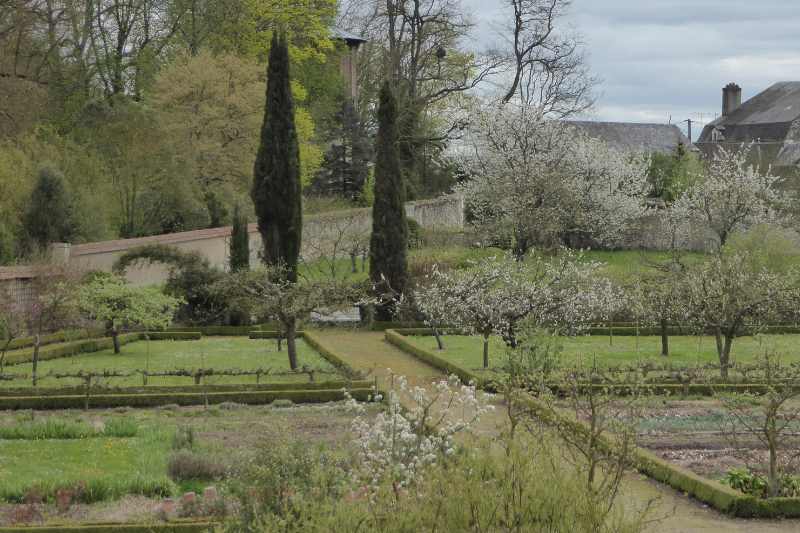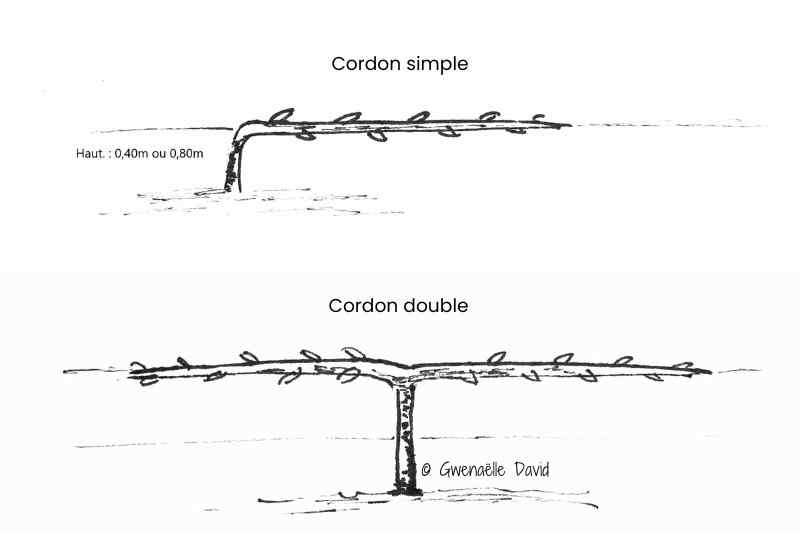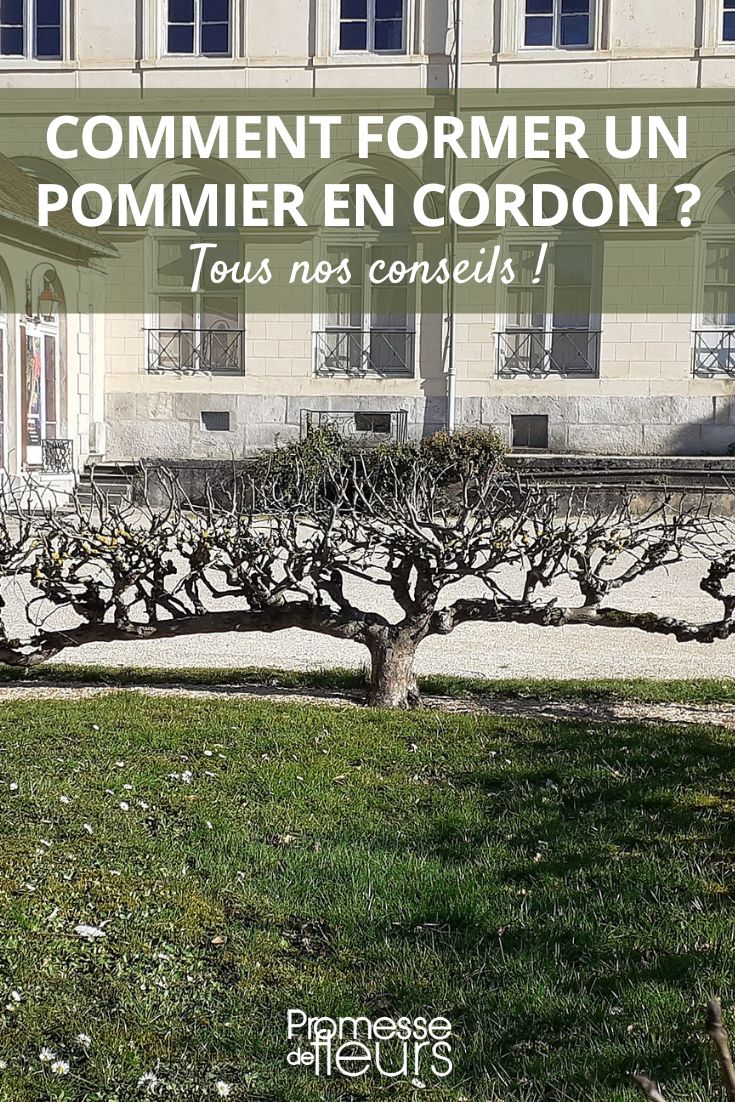- Control apple tree dimensions, which is especially useful in confined spaces. Because of its low height, the tree will be very easy to prune and maintain
- Shape your apple tree while preserving its homogeneous balance with strong main branches
- Make access to fruit easier during harvest
- Thin the branches; light penetrates better, which favours flower and fruit production. This maximises branch exposure to sun, increasing your tree's productivity.
- Make your apple tree more disease-resistant thanks to a more open branch structure that reduces vulnerability to fungal diseases (brown rot, sooty mould), because air circulation is improved.

When and how to prune an apple tree as a cordon?
Pruning is carried out between November and March, avoiding periods of severe frost. Formation of a horizontal cordon on the wire begins at planting. The cordon is formed from a scion, that is, a young plant grafted one or two years, which needs training. (fruit tree)
Forming a single-arm cordon:
- Plant 2 stakes 80 cm high, spaced 2.5 m apart and stretch between them a horizontal galvanised steel wire at 40 cm above soil to guide the cordon arms
- Plant the scion (one apple tree every 2–3 m) near a stake, ensuring the graft union is above soil level, and tie it gently to a stake about 10 cm below the wire
- Remove buds on the scion trunk located below the tie
- In the following spring, slowly bend the scion down to the wire and tie it to one side (left or right) with willow twine, it will become the cordon arm
- Then secure the horizontal section to the wire
- Prune the tip to about 30 cm from the bend, cutting back after an eye pointing downwards
- Remove buds on the scion trunk located below the tie and those situated at the level of the bend
- Each year, extend your cordon by 20–30 cm, always pruning after an eye pointing downwards
How to make a two-arm cordon?
For a two-arm cordon, the method is similar:
- Prune the young apple tree to about 1 m above soil, just above a pair of buds
- In spring, tie the two vigorous young shoots that have appeared to the stretched wire
- Fix them opposite each other at the same height. They will form the cordon's two arms
- Prune all other shoots
- During the second year, prune lateral shoots to two or three buds in summer
Maintenance of horizontal cordons
To maintain the cordon shape, regular pruning is necessary. This process encourages formation of flower buds, which will increase fruit production.
- In winter, remove vertical shoots and lateral branches on the trunk just above a bud
- Keep one spur (buds that have developed on the cordon) out of every two, ideally alternating sides along the cordon
- In summer, cut back spurs to one or two leaves
- Continue to train the cordon along the wire
- Regularly inspect the tree for signs of disease or pests. Remove diseased or damaged fruit as soon as spotted.
- My tip: The later you prune, the easier it is to distinguish buds that will produce flowers, as they will already be well swollen.
Required equipment
- A pruning shear for small branches
- A shear or a tree-pruning saw for larger branches
- A stake
- A galvanised steel wire
- a ready-to-use wound sealant for fruit trees to apply to pruning wounds
- Note: Ensure tools are thoroughly disinfected with methylated spirits to avoid spreading disease.
Cordon pruning is one of the traditional pruning methods for fruit trees. Apple trees trained as cordons, that is, horizontally on one or two arms (left and right), partition the space while producing attractive fruit. This method allows control of apple tree size and makes access to fruit easier at harvest. In addition, espaliered fruit trees are often more disease-resistant, making them a sensible choice for any gardener. Discover all our tips to train a young apple tree as a horizontal cordon, whether single-arm or two-arm, and achieve an abundance of delicious apples!

What is a horizontal cordon?
A cordon is a small apple tree trained horizontally about 60–80 cm above soil on a wire stretched between stakes. It can be single (one arm) or double (two arms). An apple tree pruned as a cordon occupies about 3 metres in width. It is an attractive, space-saving form, perfect for defining paths in a vegetable garden or distinct areas of a garden. This pruning method is ideal for small gardens and terraces, because an apple tree trained as a cordon takes up little lateral space.

Which apple tree for cordon pruning?
Although cordon pruning is mainly used on apple trees, not all apple varieties are suitable. Espalier forms such as cordons are grafted onto low- or medium-vigour rootstocks such as MM106, M9 or M26. These low-vigour rootstocks are easy to control. Cordons are available to buy already formed; although more expensive, they fruit sooner. However, by following our advice you will be able to train your apple trees yourself.
Why prune an apple tree as a cordon?
The apple tree is a fruit tree well suited to horizontal cordon training. The aim is to balance fruiting. Expect to wait about 2–3 years on these weak rootstocks before harvesting fruit. Cordon pruning allows you to:
- Control apple tree dimensions, which is especially useful in confined spaces. Because of its low height, the tree will be very easy to prune and maintain
- Shape your apple tree while preserving its homogeneous balance with strong main branches
- Make access to fruit easier during harvest
- Thin the branches; light penetrates better, which favours flower and fruit production. This maximises branch exposure to sun, increasing your tree's productivity.
- Make your apple tree more disease-resistant thanks to a more open branch structure that reduces vulnerability to fungal diseases (brown rot, sooty mould), because air circulation is improved.

When and how to prune an apple tree as a cordon?
Pruning is carried out between November and March, avoiding periods of severe frost. Formation of a horizontal cordon on the wire begins at planting. The cordon is formed from a scion, that is, a young plant grafted one or two years, which needs training. (fruit tree)
Forming a single-arm cordon:
- Plant 2 stakes 80 cm high, spaced 2.5 m apart and stretch between them a horizontal galvanised steel wire at 40 cm above soil to guide the cordon arms
- Plant the scion (one apple tree every 2–3 m) near a stake, ensuring the graft union is above soil level, and tie it gently to a stake about 10 cm below the wire
- Remove buds on the scion trunk located below the tie
- In the following spring, slowly bend the scion down to the wire and tie it to one side (left or right) with willow twine, it will become the cordon arm
- Then secure the horizontal section to the wire
- Prune the tip to about 30 cm from the bend, cutting back after an eye pointing downwards
- Remove buds on the scion trunk located below the tie and those situated at the level of the bend
- Each year, extend your cordon by 20–30 cm, always pruning after an eye pointing downwards
How to make a two-arm cordon?
For a two-arm cordon, the method is similar:
- Prune the young apple tree to about 1 m above soil, just above a pair of buds
- In spring, tie the two vigorous young shoots that have appeared to the stretched wire
- Fix them opposite each other at the same height. They will form the cordon's two arms
- Prune all other shoots
- During the second year, prune lateral shoots to two or three buds in summer
Maintenance of horizontal cordons
To maintain the cordon shape, regular pruning is necessary. This process encourages formation of flower buds, which will increase fruit production.
- In winter, remove vertical shoots and lateral branches on the trunk just above a bud
- Keep one spur (buds that have developed on the cordon) out of every two, ideally alternating sides along the cordon
- In summer, cut back spurs to one or two leaves
- Continue to train the cordon along the wire
- Regularly inspect the tree for signs of disease or pests. Remove diseased or damaged fruit as soon as spotted.
- My tip: The later you prune, the easier it is to distinguish buds that will produce flowers, as they will already be well swollen.
Required equipment
- A pruning shear for small branches
- A shear or a tree-pruning saw for larger branches
- A stake
- A galvanised steel wire
- a ready-to-use wound sealant for fruit trees to apply to pruning wounds
- Note: Ensure tools are thoroughly disinfected with methylated spirits to avoid spreading disease.
































Comments